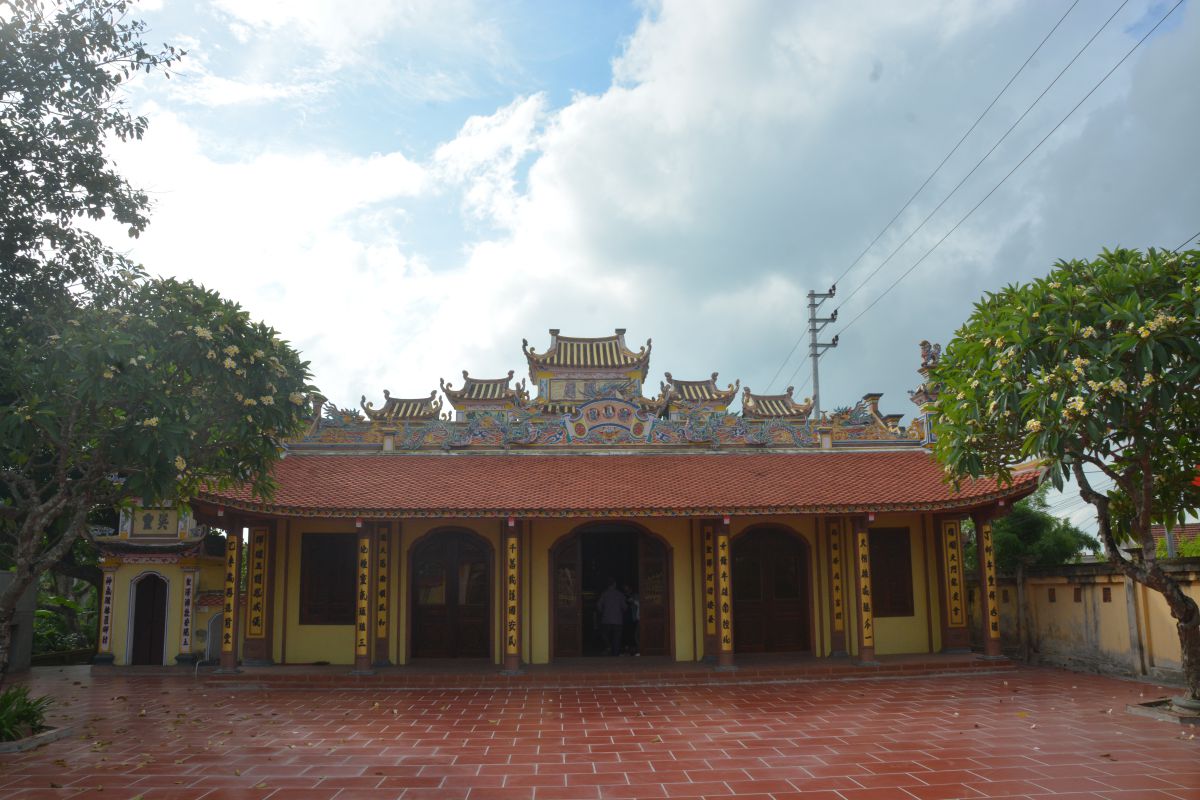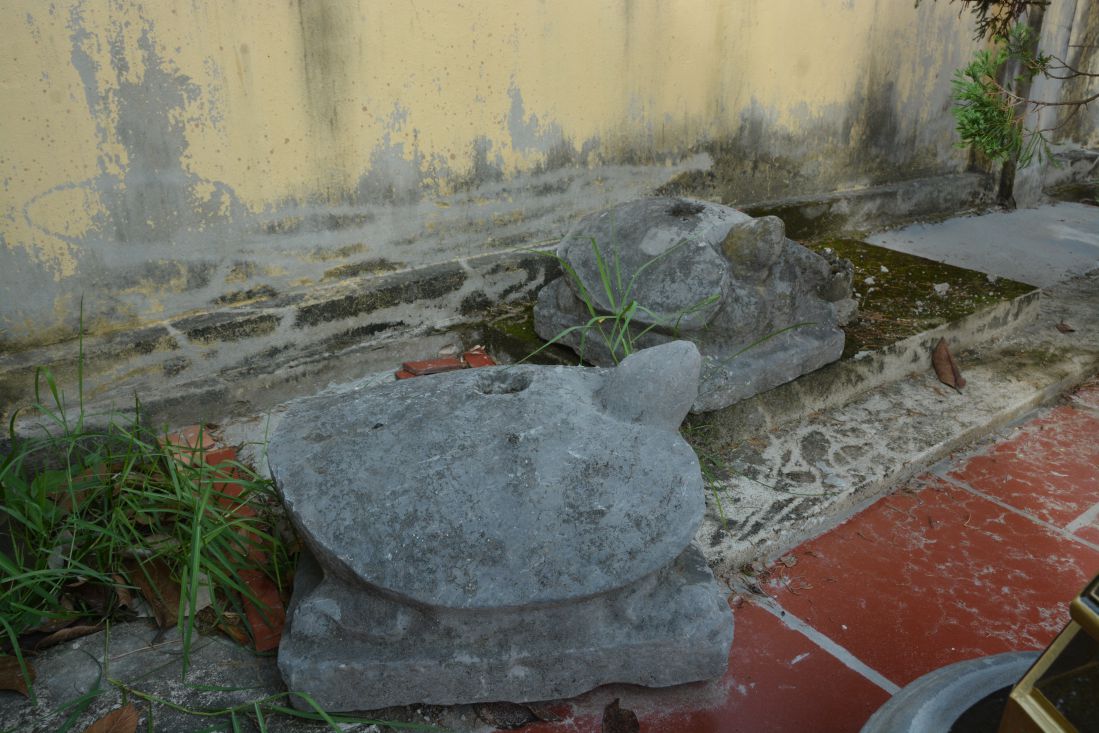This place converges great values, is a sacred place to worship the heroic King Trieu Viet Vuong, a red address marking the revolutionary spirit that broke out in the two resistance wars, and is a place to preserve the unique folk cultures of the people of the coastal areas.
Ancient traces open
The journey to find the origin of Dan Phuong communal house is a journey back in time to the early 17th century. At that time, according to the policy of encouraging the opening of the Le Dynasty, the ancestors of the Luu, Nguyen, Pham, Vu, Tran families... came here, carrying the name "Dan Phuong" from the original hometown of Hanoi to name the new land.
From a wild reed reed area, with sweat and effort to cross the sea, they create prosperous villages. Along with stabilizing their lives, their need for spiritual life urged them to join hands to build a communal house in the 18th year of Chinh Hoa (1687).
Initially, the communal house was still simple, covered with a canopy, and turned to the North. But a strange event happened, the villagers continuously suffered from epidemics. Believing that the communal house direction was not in accordance with the feudal system, in the 4th year of Vinh Huu (1739), the villagers decided to rebuild the communal house on a larger scale, more solidly and return to the South as it is today.
The communal house worships the national hero Trieu Quang Phuc, who is known as Trieu Viet Vuong. The relic still preserved at the communal house mysteriously tells the story of his life and career.

Born in Chu Dien (now Hung Yen), he was the son of a well-off family, and from a young age had a talent for fighting and martial arts. Growing up when the country was being protected by the Capitalists, Zhao Guang next door sought out reward for his father, who had been appointed as the Third General. When Ly Nam De lost power and returned to the army, he chose Da Trach lagoon (Hung Yen) - a vast swamp of mud and overgrown with reef - as a basis for carrying out the guerrilla war. According to legend, during the arduous resistance war, he was given a dragon to a dragon's key (spoke), told by a human being to fight wherever he was wearing a hat.
This legendary event is engraved in a pair of verses at the communal house:
Long Than Than Thanh Tran Tran Tran Tran Tran
The top of the pearl throne of the kings
Translation:
Dragon's nose and sky hat help Trieu
The royal phoenix throne is a precious land to worship the king.
Taking advantage of the opportunity when the army general Tran Ba Tien was called back to his country, Trieu Quang Phuc counterattacked, defeated Luong's army, and installed himself as emperor, calling himself Trieu Viet Vuong. Although he was later beaten by Ly Phat Tu with a plan to reduce the number of people and had to be exiled at Dai Nha estuary, his merits and methods will forever be remembered by the people. Dan Phuong villagers, in the process of making a living at the gate of the sea, went to the place where he monkled the priests to worship and honor him as the village's royal cities, not only as a king of national liberation but also as a protector for their sea trips and daily lives.
Ancient architecture of ancient relics
The architectural complex of Dan Phuong communal house and pagoda today is a complete complex, bearing a strong traditional artistic imprint. The gate of time of the communal house opens with the possibility of three important routes. The middle gate stands out with two raised bronze pillars, the top is made of a pillar, the body of the pillar is carved with the heart emphasizing the Old Chinese characters.
Connecting the two pillars is the elaborate "The Two Dragon Chau Nguyet" pattern. Passing through the gate is a yard of more than 300m2 paved with red bricks, leading to the main building built in the "most expensive post-nail" style. The 5-room front hall was restored in 1986 with a role-crossing roof covered with male tiles, on the porch three Chinese characters "Son Ha Tinh" (Sustainable Mountain River) floating as a affirmation of sovereignty.
The most unique highlight of the communal house is the central hall with 5 attic floors made in the style of two and eight-story, the main floor in the middle has three words "Nhat Nguyet chieu", inside are concentrated "blue bows" motifs and layered hammock doors. The most serious place is the rear of the two rooms built in the style of ancient College with two layers of roofs, which is where the examination and worship of the statue of Duc Trieu Viet Vuong is located.
Not far from the communal house is the peaceful Linh Son pagoda, facing the North, looking out at the fertile fields. The three-door gate of the pagoda is built high and majestically, the middle gate is a three-story, eight-roofed bell tower, hanging an ancient bronze bell. The main pagoda has an "etat" architecture consisting of a 5-compartment front hall and 3 consecutive three-compartment houses. Although built with modern materials, artisans cleverly decorate wooden artifacts such as main rows, northern monuments, and controversy to reduce the heaviness, creating a worship space that is both solemn and close. In addition, the ancestral houses, model roofs, and Tran Hung Dao temple form a closed, quiet complex.

Historical evidence through two resistance wars
The value of Dan Phuong communal house and pagoda does not stop at the stories of thousands of years ago. During the two resistance wars against France and the US, this place became a red address, the revolutionary center of the locality.
The village communal house was the site of the establishment of the Provisional Commune Committee in August 1945, the site of the first National Assembly election (January 6, 1946), and the site of the first Giao Thuy District Party Congress in May 1948. During the "three years and four months" (1949 - 1952) when the French occupied, the pagoda was still a secret facility, a place to dig a tunnel to raise cadres, where militia soldiers gathered after each battle.
It was at this communal house yard that in 1952, the Provincial People's Court opened a special trial to try two reactionaries, strongly encouraging the people's fighting spirit. And it was here that, on May 27, 1954, a large rally was held to celebrate the victory, the day the homeland was cleared of hostile soldiers. The communal house and sacred pagoda have immersed themselves in the national struggle, becoming a symbol of solidarity and patriotism of the people of Giao Binh.
After many changes in time and the devastation of war, especially the French bombing of Napan in 1952, Dan Phuong communal house and pagoda still stand firm thanks to the joint preservation and restoration of the government and people. From a heavily damaged relic, now a spacious architectural complex, a vivid testament to the strong vitality of Vietnamese culture, forever the pride of Giao Binh people.











